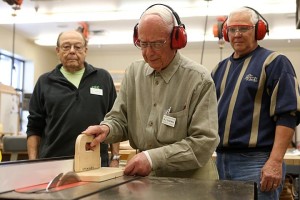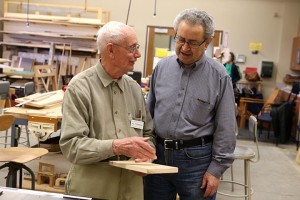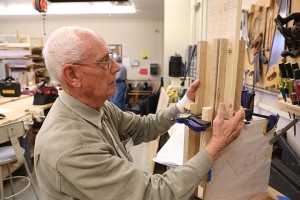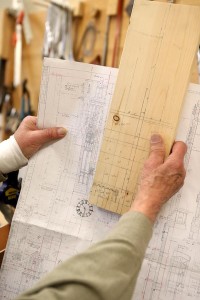Tower of Power: Alumnus leading project to miniaturize UT’s landmark
By Vicki L. Kroll
While snow was falling on a cold March day, sawdust was flying inside the warm wood shop at the Sylvania Senior Center. Camaraderie and cacophony abounded as two men put a piece of pine through a planer, and two others ran a chop saw.
Exacting precise cuts from the whirring blade was William E. Teaderman (Eng ’53), who is leading a special project for the UT Alumni Association: creating a wooden model of University Hall’s tower.
Armed with binders of research, several copies of blueprints, and a vision, Teaderman is designing a small version of UT’s awe-inspiring 205-foot collegiate Gothic landmark that has stood boldly in the west Toledo skyline since it was completed by the Spieker Co. in 1931.
UT’s tower — it’s iconic, symbolic and definitely architectonic, not to mention photogenic, poetic and academic.
No pressure for the tall order, right?
Teaderman laughed as he placed the frame of the classic structure on a work bench.

“It’s about 30 inches tall. That’s one-eighth size,” he said. “We’re trying to make as close of a replica as possible with all the damages that have been done: They’ve retrofitted the building, they remodeled the building, they repaired the building. You have to do a lot of detective work to get the feel for it.”
And Teaderman has been on the case for two years, collecting copious details and trying to confirm information about that majestic building on the south side of West Bancroft Street. He’s left no Lannon stone unturned.
If it is indeed Lannon stone.
“I’m still trying to verify that the stone work is as recorded,” he said while unfolding a map. “But where it’s written up right now, it’s in the wrong county of Wisconsin. So I can’t even tell you this is the stone they’re saying it is. A UT geology student is helping with that now.”
“The detail with which Bill has researched the history of the tower and University Hall — well, it’s easy to understand why he has been so successful in his career as an engineer and as a surveyor,” Dan Saevig, associate vice president of UT alumni relations, said.
Coincidentally, Teaderman worked for the firm that drew up the blueprints for University Hall — Mills, Rhines, Bellman & Nordhoff Inc., which was Bellman, Gillette & Richards when he was hired as a site engineer in 1960. Prior to that, he was a contract engineer with A. Bentley & Sons Co. The first bid Teaderman was awarded was for UT’s Engineering-Science Building, which is now the Health and Human Services Building. In 1965, he joined Jones & Henry Engineers Ltd. as a senior construction engineer until 1992 when he went to NCI Associates Ltd., where he stayed until 2013. The American Society of Civil Engineers Fellow continues to work as a certified surveyor in Ohio and Michigan.
“Bill has a clear vision of how the model is to be constructed,” said Dr. Samir Abu-Absi, UT professor emeritus of English and a regular at the Sylvania Senior Center wood shop. “He has been poring over blueprints and photos of University Hall and studying about the history and architecture of the building.”
“As an engineer, Bill has a great eye for detail and making sure the job is done correctly,” Julie Graf, director of the Sylvania Senior Center, said.

“Every building is designed with a personality,” Teaderman explained. “University Hall and the tower were designed to give people something to talk about, give them their flavor or frosting, because the intent of the building is to derive interest and get the students fired up to learn.”
His fire to create ignited when he was 10.
“From early on, I built models. The first one was a playhouse. My brother burnt the thing down; he was playing with a candle in the backyard,” Teaderman recalled.
That flame continued to flicker, and he majored in civil engineering at UT and took classes in University Hall.
There was another passion that consumed his collegiate days: Marilyn Sutton (Ed ’67). The two sweethearts from DeVilbiss High School continued their education together at the University. In 1949, Teaderman designed a Homecoming float for her sorority, Zeta Tau Alpha, which took the top prize, beating the float he came up with for his fraternity, Pi Rho Sigma. “She never let me forget that,” he said and laughed.

“I first got to know Bill when we were building the Koester Alumni Pavilion, and he committed to donating a pillar in memory of his wife, Marilyn, and their extended family, grateful for the impact that the University had on their lives,” Saevig said. “He truly loves UT and is so proud of what it stands for and what the future holds.”
Dedicated to UT, Teaderman offered to make the tower model so Saevig could take it to alumni events and meetings across the country.
“The tower is a source of pride with our alumni and friends,” Saevig said. “Invariably, it’s something they think of when they think of The University of Toledo. They talk of its beauty and what it represents. I suspect that the tower model will be quite popular with our alumni and friends on social media around the country.”
Chatting with everyone, Teaderman is quite popular at the Sylvania Senior Center.
 “In addition to being a great leader in the wood shop, Bill has been a great cheerleader for the Sylvania Senior Center,” Graf said. “He got people excited about the wood shop and recruited new members, educating them on the proper use of the machines.”
“In addition to being a great leader in the wood shop, Bill has been a great cheerleader for the Sylvania Senior Center,” Graf said. “He got people excited about the wood shop and recruited new members, educating them on the proper use of the machines.”
“I do have six fellows on the crew now,” Teaderman said. “Three carvers are getting ready to work on the gargoyles. And there are three wood workers. We’ve got a lot of work to do.”
Abu-Absi will be putting in some hours: “Bill can be persistent and can be very persuasive when it comes to recruiting volunteers.”
“I happened to mention that when I joined the UT faculty in 1968, I shared an office with some colleagues in a room right under the tower on the fifth floor. Later I moved to an adjoining room that included the turret; it was just large enough for a desk, a file cabinet and two chairs,” Abu-Absi said. “Having innocently volunteered that information, there was no way I could get out of being involved. Bill has recruited me to work on the turret.”
And Mike Essi (Eng ’69, MEng ’73) is sharing some time and is responsible for the Roman clock in the tower.
 Pine and chestnut are the choice woods. “Pine matches the color of the stone,” Teaderman explained. “We’ll have rough and smooth wood to reflect the field stone.”
Pine and chestnut are the choice woods. “Pine matches the color of the stone,” Teaderman explained. “We’ll have rough and smooth wood to reflect the field stone.”
The quiet, meticulous man has spent months reflecting on plans for the model.
“There are so many details we want to add; rosettes, for example, and the symbols of the colleges that are carved in the doors of the main entrance,” Teaderman said.
“I’m still trying to decide if we’re including the peregrine falcons’ nest that’s on top of the tower. We can only include so much,” he joked.








